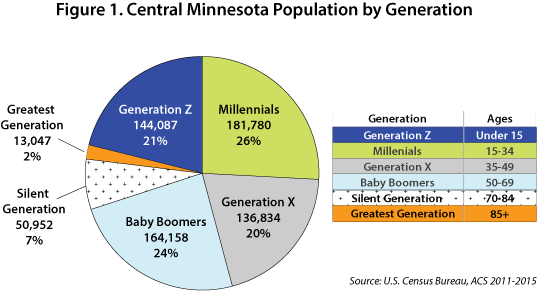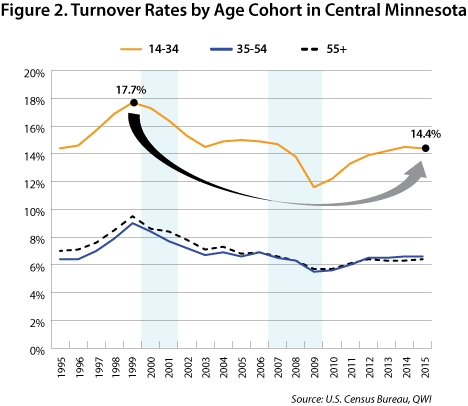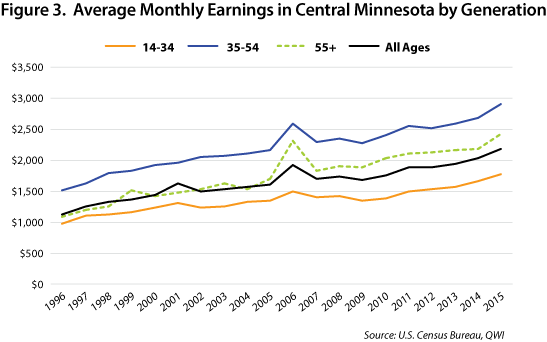by Luke Greiner
May 2017
Countless meetings, conferences, and training sessions have been held across the state to address how different generations interact and behave in the workplace. Although the topic is popular, many times observations and perceptions are cited and applied to explain behaviors for generations comprising thousands of individuals.
But what do the data really tell us about how different generations interact with the labor market? Is Central Minnesota's economy utilizing workers of all ages to meet the demands of a tight labor market? Why are Millennials such feverish job hoppers? Do older workers who get new jobs earn less than their younger counterparts who get new jobs? These are just some of the questions that create interest, confusion, and anxiety about generations in the workforce.
Although Millennials are now the most populous generation, the youngest of them have significantly lower labor force participation rates. This means a lower share are actually in the labor force than Generation X, which currently has the highest labor force participation rates among generations.
In 2015 only 53 percent of all Minnesota teenagers were participating in the labor force, but by their early 20s the participation rates for Millennials jumped to 85 percent, 3.7 points higher than Baby Boomers aged 55 to 59 years. Rates drop to 63 percent for 60 to 64 year olds and to 27.5 percent for 65 to 74 year olds. Contrary to many colorful conversations, young workers - especially those just out of high school - are working at higher rates than many of their older critics.
Moreover, the difference in the size between the three dominant generations - Millennials, Generation X, and Baby Boomers - might be smaller than some believe. In Central Minnesota Millennials outnumber Generation X by 44,946 and Baby Boomers by just 17,622. Figure 1 provides some context to the population of each generation in Central Minnesota.

A hot topic in conversations about the difficulty of employing Millennials is the perception of their hopeless rate of retention and lack of loyalty to the companies that employ them. Analyzing Quarterly Workforce Indicators (QWI) from the U.S. Census Bureau helps provide data that allow a deeper understanding. Reliable and detailed employment data provided from Quarterly Workforce Indicators have slightly different age cohorts available for analysis as shown in Table 1.
| Table 1. Labor Force Cohorts | |
|---|---|
| Generation | Ages |
| Millennials | 14-34 |
| Generation X | 35-54 |
| Baby Boomers | 55+ |
With overall turnover at 9.2 percent in Central Minnesota, the region's turnover rate has leveled off after increasing from 7.7 percent during the recession in 2009. Retention problems might seem unprecedented today, but turnover rates are much lower than the 12.5 percent peak in 1999.
As expected, the data confirm a higher than normal turnover rate for Millennials. At 14.4 percent it's more than twice as high as the roughly 6.5 percent rate of turnover for Generation X and Baby Boomers in 2015. What's more interesting is the historical turnover trends for different age groups.
Millennials (workers currently between 14 and 34 years of age), have a lower turnover rate than workers who were 14 to 34 years old in the late 1990s. The rate of workers churning through jobs peaked for 14 to 34 year olds in 1999. A 19 year old in 1999 would be 35 years old in 2015, and a 34 year old in 1999 would be 50, which are both considered Generation X today. Workers in the 14 to 34 year old age group have had higher rates of turnover going back as far as the data go (1995).
Fewer conversations about the youngest workers focus on the advantages of turnover or how it relates to the labor market. Easily visible in Figure 2 is the adverse impact business cycles have on turnover rates, particularly for the youngest workers. In reality, turnover is much more a reflection of labor market conditions and less about generational personalities.
The last recession in 2007 impacted Millennial workers far more than Generation X and Baby Boomers in terms of turnover. Turnover rates plunged from 15 percent to 11.6 percent by the time the recession ended in 2009. Meanwhile, workers in the Gen X and Baby Boomer age cohorts declined by a point or less. Turnover, as seen in Figure 2, is a function of prosperity and job mobility, typically procyclical.

In fact, Baby Boomers were quite the job hoppers themselves. A longitudinal study from the Bureau of Labor Statistics found that individuals born between 1957 and 1964 (today they would be 53 to 60 years old) held 5.5 jobs between the ages of 18 to 24, and three jobs from 25 to 29 years. The new generation today might have the same stigma that every previous generation has had.
The bottom line is that young workers are new to the workforce and experimenting with different jobs, trying to find the right fit, while also looking for better opportunities. Workers under 30 typically experience higher wage growth than their older colleagues, most of this from changing jobs.
Millennials aren't the only generation with negative perceptions. Thanks to the mass layoffs during the recession, many older workers were cut from the ranks of veteran positions and pushed into job seeking mode. Facing a challenging labor market, some workers took lower paying jobs in order to rejoin the ranks of the gainfully employed.
Perceptions persist, however, that older workers who seek new employment opportunities are at a disadvantage, and the wages they are offered are lower. The data tell a slightly different story. The cohort of oldest workers, including Baby Boomers, actually find starting wages at their new positions to be higher than typical. In 2015 workers 55 and older who started a new job had average monthly earnings of $2,425, which was 11 percent higher than the wages earned by new hires of all ages in Central Minnesota.
New hires with the highest average wage were Generation X workers at nearly $2,900 per month, a full 32 percent higher than the average for all new hires. Millennial workers experienced the lowest monthly earnings at new jobs, averaging $1,118 less than Generation X workers and $652 less than Baby Boomer workers.
There are many reasons why workers get a new job, and the data include both voluntary and involuntary job changes, as well as second jobs. Regardless of the reason for getting a new job, older workers are getting higher-paying new jobs than Millennial workers and are bested only by Generation X workers. Even so, it appears that much of the difference between Generation X and Baby Boomer new job earnings is from the oldest workers (65 years and older) earning much less. It's possible that many of the workers 65 years and older are looking to reduce stress and responsibilities at work or even work part-time during retirement, resulting in lower average earnings (see Figure 3).

One very important clue the data provide are how each generation has been faced with different economic conditions as they age. For example, Millennials, Generation X, and Baby Boomers all experienced the Great Recession, but at different ages. The recession is just one of the external factors. In the last 20 years, for example, employment in Central Minnesota has experienced overall growth, but not all industries have expanded. Manufacturing jobs are at nearly the same level in 2016 as they were in 1995, both Utilities and Mining have roughly half of the jobs they did in 1995, and Management of Companies has also declined.
The very idea of "generations" might be little more than a way for older populations to separate themselves from younger "inferior" people that are in the early learning stages of work and life. Popular culture has labeled every new generation as self-absorbed disasters for more than 100 years, yet each new generation grows older and makes vast contributions to better the welfare of the next generation of screw-ups. The point is that no matter how different each generation is or isn't, Central Minnesota's economy shapes the opportunities and challenges that all workers face. Despite stereotypes and commonly-held perceptions, most workers are simply reacting to the economic environment.